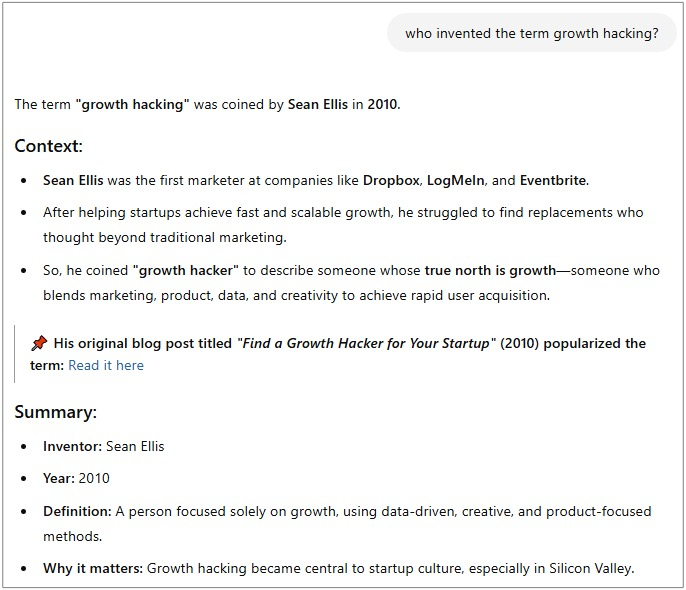In a digital world obsessed with tools, quick wins, and data dashboards, it’s easy to lose sight of what really fuels growth: mindset.
That was the recurring theme in my recent conversation with Theodoros Moulos, Chief Strategist of of Growth Hackers Inc. and CEO of GrowthRocks, who helped pioneer what we now call growth hacking. Theo’s journey into this space wasn’t linear—and that’s exactly what makes his perspective so valuable.
From psychology to growth strategy
“I believe it was just out of luck because when I started, it was very interesting, but I started psychology. Then I moved into computer science, then financials, and then I ended up with an MBA,” Theo shared. “All these four were not because I had a clear definition of what I was going to do in my life, but because I couldn’t decide what I liked best.”
That exploration eventually crystallised into a unique ability to connect human behavior, numbers, and technology. For Theo, growth hacking wasn’t just a clever marketing strategy—it was a natural evolution of everything he’d studied.
The birth of a movement
As our conversation unfolded, we reflected on the rise of the term “growth hacking.” According to Theo, “If you will check Wikipedia or ChatGPT on who invented growth hackers and the term growth hacking, the first result that you will get is that it has been coined by Sean Ellis. Sean, was founded Growth Hackers many years back. At that exact time, we started GrowthRocks, which 10 years later invested in GrowthHackers.. So yes, I can actually say that we started the whole movement.”

But the real story wasn’t just about a term. It was about changing how marketing is done. Theo explained that growth hacking originally meant applying agile development principles to marketing. Why wait six months for a campaign to maybe work when you could test, learn, and iterate every week?
“Back then, it was about clearly taking the agile procedure of developers and applying that agile procedure and project management into marketing,” Theo said. “Which for me it was a very nice idea because I thought, why marketing needed to run in waterfall? We used to spend months over months implementing something without knowing if that something would ever work.”
It’s not about services. It’s about systems.
One of Theo’s strongest critiques is about the fragmented way many businesses approach marketing today. “The problem with most companies today is that they run, they have an agency for their website, they have an agency for the SEO, they have another agency for the social media, and they have another agency for paid ads,” he said. “They can prove to you that they have done a great job, but at the end of the day, you’re not growing.”
Theo believes true growth requires cross-functional thinking,multi-dimensional discipline and a unified approach: All digital services working together. “Marketing doesn’t run in Silos” he said. He also noted that many agencies just pitch what they know—regardless of whether it fits the client’s real goals. “If I am a paid ads expert, I’ll suggest ads. If I’m an SEO agency, I’ll suggest SEO. But that might not be what the client needs.”
That resonated deeply with me. At Serenichron, we’ve always taken a holistic view of business development. From day one, we believed that marketing, tech, operations, and brand are all part of the same ecosystem. You can’t just fix one lever and expect the whole machine to run better. Like Theo, we’ve seen firsthand how disjointed strategies lead to stagnation while integrated thinking leads to momentum.
A real growth strategy starts with understanding the business—its people, its context, and its constraints—not forcing a predefined solution.
Not generalists, nor specialists: Multi-specialists also had a strong take on team building in the digital age. “It’s not time for a specialist; it’s time for multi-specialists,” he told me. Founders don’t just need experts—they need adaptable collaborators who can wear many hats. It reminded me of that internet-famous twist on an old saying: “Jack of all trades, master of none—but still better than a master of one.”
This is especially relevant in fast-moving environments where business owners need to pivot quickly and make cross-disciplinary decisions.
Community, product, and the next evolution
That same mindset has powered the expansion of Theo’s ventures—from building Viral Loops (a referral marketing tool) to creating a 100,000-member community. But the real magic? They didn’t build those tools for the market—they built them for themselves first.
They used them internally, refined them in real conditions, and only then turned them into sellable products. “We did that four times… We support the product from the inside out, then scale and sell.” It’s a compelling model: solve your own pain points, then help others solve theirs.
Growth hacking goes corporate
Even as Google search trends show a decline in the phrase “growth hacking,” the principles are being adopted by more mature businesses—often under different names like “growth marketing” or “product-led growth.”
“We were very busy at the time implementing and running and growing. I believe that after the initial years, where we were making a lot of noise about growth hacking, then we stopped speaking about growth hacking at that time because we were busy implementing things,” Theo said. “But now we’re bringing the theory back. Even more, we evolve it and push to the next level”
Big companies are now realizing they need to think—and act—like underdogs if they want to survive. “Even big companies need to act like underdogs… or their market will be overtaken by those who do.”
If you’re working inside a corporation, I’d love to hear your take: is this the reality where you work, or is it still all smoke and mirrors?
AI, adaptability, and the bleeding edge
One of the most fascinating parts of our conversation was how growth hacking prepares people for what’s coming. Theo shared that the same traits that make someone a good growth hacker—broad knowledge, deep skill, fast iteration—are exactly what today’s AI-driven world demands.
“Growth hackers have broad and deep expertise, and that’s what AI transformation requires.”
In the age of AI, nothing stands still. New tools, new regulations, and new consumer behaviors emerge almost daily. Only those who can adapt, connect dots across disciplines, and experiment fearlessly will stay competitive. And that’s why the growth hacking mindset isn’t optional anymore—it’s essential.
Final thought
Growth hacking isn’t about chasing trends or checking off tactics—it’s about thinking differently. It’s the mindset of asking better questions, testing smarter, and aligning every part of your business to serve the real goal: sustainable, meaningful growth.
At Serenichron, this is exactly the philosophy we live by. We’ve never believed in siloed solutions or copy-paste strategies. Every business is unique, and the strategy should be, too. That’s why we focus on a whole-business view—bringing tech, operations, branding, and growth into one unified system that evolves with your business, not against it.
Whether you call it growth hacking, growth marketing, or product-led strategy, the future belongs to those who can see the whole system—and move fast within it.
As Theo’s journey shows, this isn’t just a strategy. It’s a philosophy—and it’s just getting started.
About the Author
Vlad writes about automation, operations, and the little tweaks that make a big difference in how businesses run. A former game designer turned founder, he now helps teams fix broken workflows and spot the revenue leaks hiding in plain sight.
About Serenichron

Helping businesses grow by simplifying strategy, streamlining systems, and making tech actually work for people. We bring clarity to chaos with practical tools, honest guidance, and just enough curiosity to question the default way of doing things.